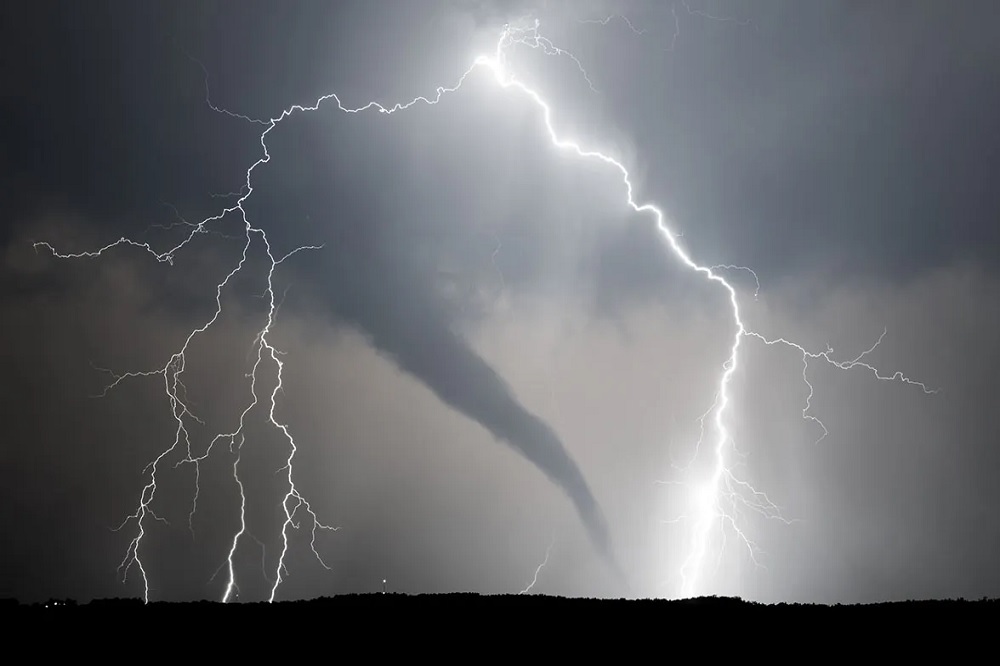Unbelievable weather phenomena are happening all around us. Ancient lakes are reappearing in California’s deserts, the Sahara Desert has been blanketed by snow, and lightning storms have begun striking the Arctic with increasing frequency. From “blood rain” in Europe to hurricanes rapidly intensifying at unprecedented rates, these occurrences have left scientists and the public alike questioning whether nature alone is behind these changes—or if unseen hands are steering our weather.
While these phenomena can be attributed to natural forces or climate change, they also coincide with the advancement of weather manipulation technologies. What if these events are not purely natural? Could globalists, governments, or private entities be engineering the weather to sow chaos, gain political and economic power, and reshape global order?
Weather Manipulation: From Conspiracy to Reality
Weather manipulation is no longer a fringe conspiracy theory; it is a documented reality with historical roots, modern applications, and far-reaching implications. Governments and private entities have developed technologies capable of altering rain patterns, steering storms, and even triggering droughts. This article investigates the history, patents, and controversies surrounding weather control, focusing on whether globalists are wielding these technologies as a tool for chaos and control.
The Origins of Weather Manipulation Technology
Efforts to manipulate the weather date back to the mid-20th century:
- Project Cirrus (1947-1952): Conducted by the United States Air Force and General Electric, this project experimented with cloud seeding using silver iodide to influence hurricanes. Although results were mixed, it laid the groundwork for future weather manipulation technologies (RAND).
- Project Stormfury (1962-1983): The U.S. government attempted to weaken hurricanes by seeding their eyewalls with silver iodide. While the program ended due to inconsistent results, it demonstrated the military’s serious interest in storm pattern manipulation (AFP Fact Check, RAND).
China’s Weather Modification Programs
China leads the world in weather modification, deploying cutting-edge techniques through its Beijing Weather Modification Office. Highlights of their program include:
- Cloud Seeding for Events: During the 2008 Beijing Olympics, Chinese officials preemptively seeded clouds to trigger rain before events, ensuring clear skies during critical moments (livescience.com).
- Expanding Precipitation: China aims to increase annual rainfall in arid regions by 30% using advanced cloud manipulation techniques. These efforts underscore the dual purpose of weather control for environmental benefits and geopolitical leverage (Media Matters).
Unbelievable Weather Phenomena
In recent years, we’ve witnessed an array of extraordinary weather events that push the boundaries of natural explanations:
- Reappearing Lakes in California’s Desert: Torrential rains have filled ancient lakebeds in Death Valley, creating water bodies in one of the driest places on Earth.
- Snowfall in the Sahara Desert: Multiple instances of snow blanketing the world’s hottest desert have stunned meteorologists, with the most recent event in 2021.
- Blood Rain in Europe: Rain tinged red by Saharan duststorms has fallen across Spain and other European nations, creating eerie, apocalyptic scenes.
- Hurricanes Defying Logic: Rapid intensification events, like Hurricane Otis hitting Acapulco in 2023, challenge established meteorological patterns.
- Arctic Lightning Storms: Once considered nearly impossible, lightning storms in the Arctic are becoming more frequent, signaling dramatic atmospheric shifts.
These phenomena fuel speculation about whether nature alone is responsible or if technologies are being deployed to manipulate these events.
The Science of Weather Manipulation
Weather manipulation hinges on altering atmospheric conditions like moisture levels, pressure systems, and temperatures. Key methods include:
- Hurricanes: By increasing moisture in specific areas or creating artificial pressure systems, hurricanes can be steered or intensified. These storms thrive on warm ocean waters and atmospheric instability, making them vulnerable to strategic intervention (NASA Science).
- Tornadoes: Tornadoes form when warm, moist air meets cool, dry air, creating rotating updrafts (mesocyclones). Adjusting these variables could theoretically intensify or redirect tornadoes (AIP Publishing, NOAA National Severe Storms Laboratory).
Patents and Technologies in Weather Control
A wealth of patents exists for weather manipulation technologies:
- Cloud Seeding: Silver iodide or other materials are dispersed into clouds to induce rain or snow (RAND).
- Storm Steering: Thermal energy and pressure zones are manipulated to guide storms or amplify their intensity (AOML, livescience.com).
- Geoengineering: Satellite technology reflects sunlight away from Earth to cool the atmosphere and influence weather patterns (Northrop Grumman).
Floods and Droughts: Engineered Extremes
Weather manipulation can create devastating outcomes when misused:
- Flood Creation: Increasing rainfall in specific areas can overwhelm watersheds and cause flooding. These events can be triggered through targeted cloud seeding (NASA Science).
- Drought Induction: Preventing moisture from reaching a region by creating artificial high-pressure systems can lead to prolonged droughts. Countries like Israel and Iran have accused each other of such actions (National Geographic Society).
The Controversial North Carolina Lithium Case
The North Carolina Carolina Tin-Spodumene Belt, home to valuable lithium reserves, became a hotbed of speculation when hurricanes like Helene caused unprecedented flooding in resource-rich areas. Critics suspect geoengineering was used to make the land more accessible for mining interests.
- Corporate Interests: Companies like BlackRock and Vanguard, which hold significant shares in lithium mining, stand accused of benefiting from these disasters. While the full extent of weather manipulation remains unclear, the presence of weather modification patents lends weight to these allegations (Media Matters, Northrop Grumman).
Geopolitical Implications
The global use of weather control extends beyond the United States and China. Russia has experimented with weather manipulation to combat droughts and influence agricultural outcomes. According to the RAND Corporation, as these technologies develop, they may become tools for controlling resources, populations, and even economies.
- Outdated Treaties: The 1976 Environmental Modification Convention prohibits using weather modification as a weapon, but it lacks enforcement mechanisms. Without updated regulations, nations or corporations could use these technologies unchecked (NASA Science, RAND).
Conclusion: Chaos or Progress?
From snow in deserts to storms that defy logic, the natural world is changing—or is it being changed? The line between natural phenomena and engineered weather is increasingly blurred as technologies advance and the stakes grow higher.
Weather manipulation technologies, while offering solutions for water scarcity and disaster prevention, also hold the power to create chaos, disrupt democracies, and reshape global power dynamics. As we face a world where weather can be engineered, the need for transparency, oversight, and international regulation is more urgent than ever.
The question remains: Are globalists engineering storms and droughts to create chaos, or are these extraordinary phenomena purely the work of nature? Until more light is shed on these technologies and their applications, the truth remains clouded.




